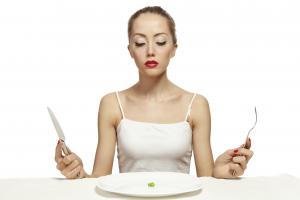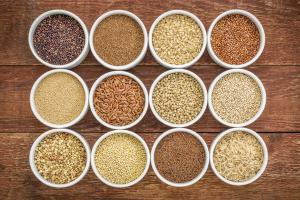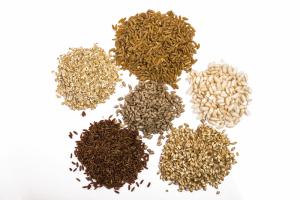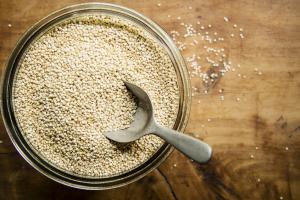The rise of the good carb (and how to spot one)
Cutting out all carbs is so last year. Now, it’s all about good carbs, that’s carbohydrates that keep you full and provide sustained energy, says Anna Magee
It’s almost less shocking to admit you’re in AA these days than to order the pasta or God forbid, take a swipe at the bread basket with the actual intention of eating a carbohydrate.  Since the onset of popular diets like Atkins circa 2003 and more recently Paleo â€" still one of the most Googled diets on the planet â€" extoling the virtues of meat and fat and shunning all starches including rice, bread, potatoes and pasta (even poor old porridge, once considered breakfast of champions), ‘cutting carbs’ has become shorthand for ‘on a diet but not’. As a result, carb-phobia has spread like wildfire. Supermarket sales of bread in Britain dropped by 8.9 per cent in 12 months according to a report by market analysts Nielsen. Even in Italy, where pasta was born, sales of the starchy staple dropped by a staggering 25 per cent since 2009, according to data from market research firm Euromonitor.
MORE: 10 good carbs your diet needsÂ
What’s cutting carbs doing to your body?
But something isn’t working with no- or low-carb diets. Not only are we the fattest people in Europe we’re also more tired, more hungry and more depressed than ever. ‘In terms of everyday health, dropping or cutting carbohydrates can make people feel fatigued because muscles like glycogen as a fuel,’ explains Dr Alex Johnstone, a lecturer in of nutrition at the Rowett School of Nutrition and Public Health at the University of Glasgow.
Carbohydrate is also the preferred form of fuel for the brain
When we eat carbohydrates, they turn into glycogen in muscles, which is the fuel that gives us that ‘oooomph’ needed when we exercise. ‘Carbohydrate is also the preferred form of fuel for the brain too,’ says Dr Johnstone. It’s one of the reasons people get headachey, foggy-headed or irritable on high protein, no carb diets, especially at their outset.
No-carb diets are now being found to affect gut health too. ‘Eating no-carb, high-protein can lead to the production of potentially harmful compounds called n-nitroso produced in the gut,’ she says. Indeed, studies have found that very high protein diets may increase the risk of colonic disease thanks to their production of such compounds. ‘Eating slow-release carbohydrates, can act as a buffer to help protect the gut from these.’
Why good carb is the new low carb
Indeed, a dearth of nutrition experts are now calling time on the war on carbs, claiming that eating the right types could keep us more satisfied, help us lose weight, increase our energy and even stop food cravings. For such experts, slowly digestible carbohydrates in their most natural states are making a comeback on the nutritional stage.
Still, too many of the wrong types of carbohydrates do indeed make you fat, which is why white and processed carbohydrates such as sugars, pasta, commercial breads and doughs, rice and potatoes are still off the menu. ‘Rapidly digesting carbohydrates raise insulin levels higher than they would eating a natural diet,’ says Dr David Ludwig, professor of nutrition at Harvard School Public Health and author of new book, Always Hungry: Conquer cravings, retrain your fat cells and lose weight permanently (Orion £20).
The key is to eat foods that lower insulin levels by replacing processed carbs with slow-acting carbs
‘Insulin is the ultimate fertiliser for your fat cells and directs too many of the calories you’re eating straight into them, then locks the door. The key is to eat foods that lower insulin levels by replacing processed carbs with slow-acting carbs,’ says Prof. Ludwig. ‘That makes your fat cells open up and release all the pent up calories into the bloodstream. Your brain says ‘I like this, I have good access to fuel so I can turn off hunger and cravings,’ and your muscles love it because it redirects fuel to them for fitness and exercise and helps build lean muscle.’
How to swap smart
In her latest book Smart Carbs (Orion £16.99), TV presenter Davina McCall, advocates distinguishing between ‘dumb’ and ‘smart’ carbs in much the same way that Dr Ludwig names them ‘fast’ and ‘slow’.
Not all carbs are created equal
Dumb carb examples are cream crackers, white potatoes, and cornflakes while smart ones are oatcakes, sweet potatoes and porridge. ‘Smart carbs is just a new name for the types of carbs we’ve been telling people to eat for years,’ says Fiona Hunter, the registered nutritionist who advised McCall on the book. What makes these carbs ‘smart’ is threefold, she explains. First, they’re low on the Glycaemic Index or GI which relates to how quickly they turn to glucose in our blood stream. Low is usually considered 55 or less (find a list at glycaemicindex.com). ‘Second, they’re higher in fibre so you get fuller with smaller portions, which is great for weight loss,’ she says. ‘Lastly, they’re higher in nutrients, so for example, a sweet potato will contain more minerals like betacarotene and b-vitamins than the bog standard white spud.’
Consumers, too, are recognising not all carbs are created equal. A 2015 survey of 5000 people across five European countries including the UK found they made a distinction between ‘good’ (natural, unprocessed, slow energy release) and ‘bad’ (refined, white, fast energy release) carbs.
What’s with all these new power grains?
Among the hottest smart carbs exciting the experts are a newly discovered group of slow energy-releasing ‘heritage’ grains including the uber-fashionable quinoa â€" pronounced keen-waâ€" and many more with even weirder names like farro, teff and kamut, favoured by traditional societies.
White bread, or even what passes as wholegrain bread on supermarket shelves today, is made from flour that’s been pulverised into tiny particles that your body will digest very quickly making you hungry again fast
‘These are the grains our grandparents ate that are released as glucose very slowly into the bloodstream,’ says Prof. Ludwig. ‘White bread, or even what passes as wholegrain bread on supermarket shelves today, is made from flour that’s been pulverised into tiny particles that your body will digest very quickly making you hungry again fast,’ he explains. ‘On the other hand old world breads such as German pumpernickel or old world sour dough breads are made with the rye grains still intact so they’re very slow digesting’. You’ll be kept satisfied for longer because their energy is released so slowly and you’ll want less because their high fibre content keeps you full, he explains.
Indeed, just last week barley, a grain used traditionally in dishes such as Scotch broth was found to pack substantial nutritional punch. Scientists at Lund University in Sweden asked a group of middle-aged volunteers to eat a serve of barley three times a day and found that 11-14 hours after their final meal their metabolisms had improved, their blood sugar and insulin levels a had decreased and they had improved appetite control thanks to what the scientists observed was an increase in gut hormones that regulated their metabolism and appetite. Previous research also found that eating barley could help stimulate healthy bacteria in the gut.
What’s wrong with wheat today?
‘These are more nutritious than today’s wheat from which our bread and pasta products are made, their colours mean they contain plant chemicals that are hugely beneficial to health.’ Modern wheat, he explains, has been ‘hybridised’ to make the most delicious tasting bread ‘for immediate taste gratification purposes but it’s not supporting health.’ On the other hand, these ancient grains are closer to the way grains would have existed in nature thousands of years ago than our modern wheat varieties, meaning many of their nutrients would still come intact.
How much, how often?
Dr Ludwig suggests having three serves of slow carbs a day for optimum health and weight loss. In terms of how much to eat, Fiona Hunter says 50 grams per serve or as much you can hold in your cupped hand of grains uncooked. If you’re after the ratio you need in your diet of carbohydrates, Prof. Johnstone’s studies have found that for weight loss, the optimum is having 30 per cent of your diet come from proteins such as legumes, tofu, fish, chicken and lean meats, 30 per cent from healthy fats such as nuts, nut butters, olive and other vegetable oils and 40 per cent come from slow-releasing carbohydrates.
So, next time you’re in a trendy restaurant, feel free to order that exotic sounding grain or bread that’s on the menu, just make sure you can pronounce it.
MORE BY HEALTHISTA:
10 FOODS THAT INCREASE FERTILITY
CAN FERMENTED FOODS CHANGE YOUR LIFE?
10 HEALTHY FATS THAT COULD HELP YOU LOSE WEIGHT
WHAT DERMATOLOGISTS EAT FOR GREAT SKIN




0 comments:
Post a Comment